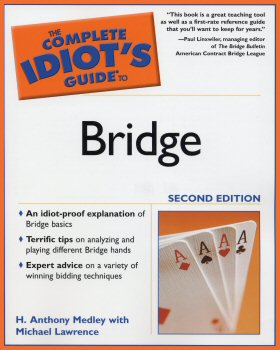| The first edition of Complete Idiot's Guide to Bridge by H. Anthony Medley was the fastest selling beginning bridge book, going through more than 10 printings. This updated Second Edition includes some modern advanced bidding systems and conventions, like Two over One, a system used by many modern tournament players, Roman Key Card Blackwood, New Minor Forcing, Reverse Drury, Forcing No Trump, and others. Also included is a detailed Guide to Bids and Responses, along with the most detailed, 12-page Glossary ever published, as well as examples to make learning the game even easier. Click book to order. | ||
|
Imax Hubble 3D (8/10) by Tony Medley Run time 47 minutes. OK for children. Hereís a description of The Hubble Telescope: The Hubble Space Telescope (HST) is a space-based telescope that was launched in 1990 by the space shuttle. From its position 353 miles (569 km) above Earth's surface, the HST has expanded our understanding of star birth, star death, and galaxy evolution, and has helped move black holes from theory to fact. In its first 15 years, the telescope recorded over 700,000 images. Hubble's view is so spectacular because of its location above Earth's atmosphere. Shifting pockets of air distort light from space - that's why stars seem to twinkle when viewed from the ground. Furthermore, the atmosphere blocks some wavelengths of light partially or entirely, making space the only place where it is possible to get a truly clear and comprehensive view of the universe. The Hubble Space Telescope was dying, so in May, 2009, the Shuttle Atlantis flew to service it. This is the film showing what they did in 3D. Narrated by Leonardo DiCaprio, produced and directed by Toni Myers, Director of Photography James Neihouse also served as the crew trainer for the astronauts. In addition to watching the enormously meticulous and detailed work they had to do while floating in space to repair the telescope, the film includes 3D images of outer space. The Universe is big, but a few numbers will help to give a clue as to how enormous it really is. The nearest galaxy to The Milky Way, where we reside, is Andromeda. How far is ďnear?Ē Two and a half million light years away, thatís how far! OK, you got that? The light we see of the nearest galaxy to the Milky Way was emitted two and a half million years ago! The Milky Way itself is 90,000 light years in diameter. Now, how many galaxies are there in the universe? Over a billion! And the nearest to the Milky Way is 14,664,240,000,000,000,000 miles away. So thatís just two galaxies; two that are close to one another. There are a billion more galaxies, each containing 100 billion or more stars like our sun, some much bigger, some smaller. How big is the universe? Itís beyond human comprehension. This film takes us, through the magic of The Hubble telescopeís extraordinary pictures, to the Virgo Cluster, which is home to over 2,000 galaxies (remember, our galaxy is 90,000 light years in diameter). Although most of the film is about repairing the telescope, there are some eye-popping shots of the Universe. One of the final images of this remarkable film is a picture of the universe in 3D. I canít even begin to describe it.
|
||
